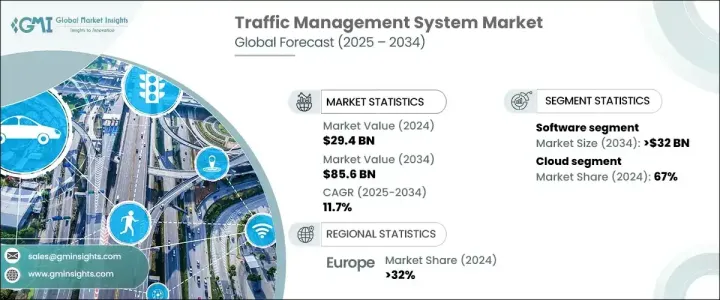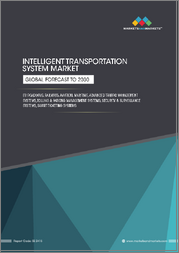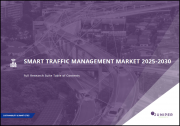
|
시장보고서
상품코드
1684845
교통 관리 시스템 시장 기회, 성장 촉진요인, 산업 동향 분석, 예측(2025-2034년)Traffic Management System Market Opportunity, Growth Drivers, Industry Trend Analysis, and Forecast 2025 - 2034 |
||||||
세계의 교통 관리 시스템 시장은 2024년에 294억 달러로 평가되었고 2025년부터 2034년에 걸쳐 11.7%의 연평균 복합 성장률(CAGR)을 나타낼 것으로 예측되어 대폭적인 확대가 전망되고 있습니다.
도시 경관이 계속 발전하고 도시의 인구 밀도가 높아짐에 따라 고급 교통 관리 솔루션에 대한 긴급성은 전례없는 수준에 도달했습니다. 기존의 교통관리 전략에서는 교통 체증을 완화하고 이동성을 높이고 환경 문제를 효과적으로 해결하기가 어렵습니다. 이러한 복잡성은 교통 시스템의 간소화, 지연 감소, 교통 흐름 최적화를 위한 혁신적인 교통 관리 기술의 도입을 가속화하고 있습니다.

지능형 교통 솔루션에 대한 수요는 실시간 데이터, 예측 분석 및 자동 제어 시스템에 대한 의존도가 증가함에 따라 증가하고 있습니다. 세계의 도시들은 인공지능(AI), 사물인터넷(IoT), 빅데이터 분석 등의 첨단기술을 교통망에 통합하여 보다 나은 조정과 교통효율 개선을 가능하게 하고 있습니다. 정부 및 도시 계획 담당자는 이러한 솔루션이 교통 안전, 연료 소비 감소, 온실 가스 배출량 감소에 기여함으로써 고급 교통 관리 시스템에 투자하는 이점을 알고 있습니다. 그 결과 세계 시장에서는 당국과 민간 사업체가 제휴하여 차세대 교통 관리 메커니즘을 도입함으로써 스마트 인프라에 대한 큰 뒷받침을 볼 수 있게 되었습니다.
| 시장 범위 | |
|---|---|
| 시작 연도 | 2024년 |
| 예측 연도 | 2025-2034년 |
| 시작 금액 | 294억 달러 |
| 예측 금액 | 856억 달러 |
| CAGR | 11.7% |
시장은 하드웨어, 소프트웨어, 서비스로 분류되며, 소프트웨어 솔루션은 현대 교통 관리를 형성하는데 매우 중요한 역할을 합니다. 2024년 시장 점유율은 소프트웨어가 40%를 차지했고 2034년에는 320억 달러에 이를 것으로 예측됩니다. 첨단 소프트웨어 솔루션을 통해 당국은 실시간 교통 분석을 활용하고 신호 타이밍을 최적화하며 정체를 더욱 정확하게 관리할 수 있습니다. 이러한 플랫폼은 서로 다른 교통 네트워크 간의 원활한 커뮤니케이션을 촉진하여 도시가 변동하는 교통 패턴에 효율적으로 적응할 수 있도록 합니다. AI를 활용한 교통 분석과 클라우드 기반 플랫폼을 통합함으로써 지자체는 안전성을 대폭 향상시키고 통근 시간을 단축하며 보다 지속 가능한 교통 생태계를 확보할 수 있습니다.
교통 관리 시스템 시장을 구축하는 방법은 클라우드 기반과 온프레미스 솔루션으로 나뉘며 클라우드 기반 시스템이 압도적인 힘을 보이고 있습니다. 2024년 시장 점유율의 67%를 차지한 클라우드 기반 솔루션은 확장성, 유연성 및 비용 효과로 전통적인 온프레미스 모델을 급속히 능가하고 있습니다. 도시가 고도로 상호 연결된 데이터 중심 환경으로 전환하는 동안 클라우드 기술은 큰 변화를 가져오고 있습니다. 클라우드 기술은 여러 데이터를 원활하게 통합하여 교통 시스템의 민첩성과 실시간 상황에 대한 대응력을 유지할 수 있습니다. 또한 클라우드 기반 플랫폼은 대규모 하드웨어 인프라를 필요로 하지 않으므로 미래에 대비할 수 있는 교통 관리 솔루션의 도입을 고려하는 지자체에게 선호되는 옵션이 되었습니다.
2024년 시장 점유율은 유럽이 32%를 차지했고 기술 진보, 스마트 시티 구상, 세계 톱 클래스의 교통 인프라에 대한 강한 헌신이 그 원동력이 되었습니다. 경제가 견조한 국가들은 AI, IoT, 빅데이터, 클라우드 컴퓨팅을 교통 관리 시스템에 통합하는 최전선에 있으며, 보다 안전하고 효율적인 도로망으로의 길을 열고 있습니다. 유럽 도시는 교통 체증을 최소화하고 이동성을 강화하고 지속가능성을 촉진하기 위해 디지털 혁신을 활용하며 교통 관리에서 세계 벤치마크를 설정합니다. 지능형 교통 솔루션에 대한 지속적인 투자로 인해 이 지역은 세계의 교통 관리 시스템 시장에서 주요 기업이 될 것으로 예상됩니다.
목차
제1장 조사 방법과 조사 범위
- 조사 디자인
- 조사 접근
- 데이터 수집 방법
- 기본 추정과 계산
- 기준연도의 산출
- 시장추계의 주요 동향
- 예측 모델
- 1차 조사와 검증
- 1차 정보
- 데이터 마이닝 소스
- 시장 정의
제2장 주요 요약
제3장 업계 인사이트
- 생태계 분석
- 기술 공급자 및 솔루션 개발자
- 커넥티비티 및 통신 제공업체
- 시스템 통합업체
- 최종 용도
- 공급자의 상황
- 이익률 분석
- 기술과 혁신의 전망
- 주요 뉴스와 대처
- 규제 상황
- 사례 연구
- 영향요인
- 성장 촉진요인
- 세계의 도시화의 진전
- 정부 투자 및 규제 지원
- 교통 관리 시스템의 기술적 진보
- 효율적인 운송에 대한 수요 증가
- 고도분석과 빅데이터 채용 증가
- 업계의 잠재적 위험 및 과제
- 높은 초기 투자 및 운영 비용
- 프라이버시와 데이터 보안에 대한 우려
- 성장 촉진요인
- 성장 가능성 분석
- Porter's Five Forces 분석
- PESTEL 분석
제4장 경쟁 구도
- 서론
- 기업 점유율 분석
- 경쟁 포지셔닝 매트릭스
- 전략 전망 매트릭스
제5장 시장 추계·예측 : 기술별(2021-2034년)
- 주요 동향
- AI 및 ML
- 사물인터넷(IoT)
- 클라우드 기반
- 빅 데이터 분석
- 기타
제6장 시장 추계·예측 : 구성 요소별(2021-2034년)
- 주요 동향
- 하드웨어
- 교통 신호 및 컨트롤러
- 센서
- 카메라 및 감시 시스템
- 가변 메시지 표지판
- 소프트웨어
- 교통 분석
- 스마트 신호
- 경로 안내
- 교통 모니터링
- 서비스
- 컨설팅
- 배포 및 통합
- 지원 및 유지 보수
제7장 시장 추계·예측 : 용도별(2021-2034년)
- 주요 동향
- 도시 교통 관리
- 고속도로 교통 관리
- 대중교통 관리
- 주차 관리
- 사고 관리
- 통합 회랑 관리(ICM)
- 기타
제8장 시장 추계·예측 : 배포 모드별(2021-2034년)
- 주요 동향
- 온프레미스
- 클라우드
제9장 시장 추계·예측 : 최종 용도별(2021-2034년)
- 주요 동향
- 정부 및 지자체
- 교통 기관
- 민간 기관
제10장 시장 추계·예측 : 지역별(2021-2034년)
- 주요 동향
- 북미
- 미국
- 캐나다
- 유럽
- 영국
- 독일
- 프랑스
- 스페인
- 이탈리아
- 러시아
- 북유럽
- 아시아태평양
- 중국
- 인도
- 일본
- 한국
- 뉴질랜드
- 동남아시아
- 라틴아메리카
- 브라질
- 멕시코
- 아르헨티나
- 중동 및 아프리카
- UAE
- 남아프리카
- 사우디아라비아
제11장 기업 프로파일
- Cisco
- Cohda Wireless
- Cubic
- Huawei Technologies
- IBM
- Intel
- Iteris
- Jenoptik
- Kapsch
- Metro Infrasys
- Omnitec Systems
- Q-Free
- Sick
- Siemens
- Sumitomo
- Swarco
- Teledyne FLIR
- Thales
- TomTom International
- TransCore
The Global Traffic Management System Market, valued at USD 29.4 billion in 2024, is poised for significant expansion, with projections indicating a robust CAGR of 11.7% between 2025 and 2034. As urban landscapes continue to evolve and cities become more densely populated, the urgency for advanced traffic management solutions is reaching unprecedented levels. Conventional traffic control strategies struggle to mitigate congestion, enhance mobility, and address environmental concerns effectively. This growing complexity has accelerated the adoption of innovative traffic management technologies designed to streamline transportation systems, reduce delays, and optimize traffic flow.

The demand for intelligent traffic solutions is being fueled by the increasing reliance on real-time data, predictive analytics, and automated control systems. Cities worldwide are integrating sophisticated technologies such as artificial intelligence (AI), the Internet of Things (IoT), and big data analytics into their transportation networks, enabling better coordination and improved traffic efficiency. Governments and urban planners recognize the advantages of investing in advanced traffic management systems, as these solutions contribute to road safety, lower fuel consumption, and reduced greenhouse gas emissions. As a result, the global market is witnessing a significant push toward smart infrastructure, with authorities and private entities partnering to deploy next-generation traffic control mechanisms.
| Market Scope | |
|---|---|
| Start Year | 2024 |
| Forecast Year | 2025-2034 |
| Start Value | $29.4 Billion |
| Forecast Value | $85.6 Billion |
| CAGR | 11.7% |
The market is categorized into hardware, software, and services, with software solutions playing a pivotal role in shaping modern traffic management. In 2024, software accounted for a substantial 40% market share, and forecasts suggest it will generate USD 32 billion by 2034. Advanced software solutions enable authorities to leverage real-time traffic analysis, optimize signal timings, and manage congestion with greater precision. These platforms facilitate seamless communication between different transportation networks, ensuring that cities can adapt to fluctuating traffic patterns efficiently. By integrating AI-powered traffic analytics and cloud-based platforms, municipalities can significantly enhance safety, reduce commute times, and ensure a more sustainable transportation ecosystem.
Deployment methods in the traffic management system market are split between cloud-based and on-premises solutions, with cloud-based systems emerging as the dominant force. Capturing 67% of the market share in 2024, cloud-based solutions are rapidly outpacing traditional on-premises models due to their scalability, flexibility, and cost-effectiveness. As cities transition into highly interconnected data-driven environments, cloud technology is proving to be a game-changer. It allows seamless integration of multiple data points, ensuring that traffic systems remain agile and responsive to real-time conditions. Moreover, cloud-based platforms eliminate the need for extensive hardware infrastructure, making them a preferred choice for municipalities looking to implement future-ready traffic management solutions.
Europe accounted for a significant 32% market share in 2024, driven by its strong commitment to technological advancements, smart city initiatives, and world-class transportation infrastructure. Countries with robust economies are at the forefront of integrating AI, IoT, big data, and cloud computing into traffic management systems, paving the way for safer and more efficient road networks. European cities are setting a global benchmark in traffic control, leveraging digital transformation to minimize congestion, enhance mobility, and promote sustainability. With continued investments in intelligent transportation solutions, the region is expected to remain a key player in the global traffic management system market.
Table of Contents
Chapter 1 Methodology & Scope
- 1.1 Research design
- 1.1.1 Research approach
- 1.1.2 Data collection methods
- 1.2 Base estimates and calculations
- 1.2.1 Base year calculation
- 1.2.2 Key trends for market estimates
- 1.3 Forecast model
- 1.4 Primary research & validation
- 1.4.1 Primary sources
- 1.4.2 Data mining sources
- 1.5 Market definitions
Chapter 2 Executive Summary
- 2.1 Industry 3600 synopsis, 2021 - 2034
Chapter 3 Industry Insights
- 3.1 Industry ecosystem analysis
- 3.1.1 Technology providers & solution developers
- 3.1.2 Connectivity & communication providers
- 3.1.3 System integrators
- 3.1.4 End use
- 3.2 Supplier landscape
- 3.3 Profit margin analysis
- 3.4 Technology & innovation landscape
- 3.5 Key news & initiatives
- 3.6 Regulatory landscape
- 3.7 Case studies
- 3.8 Impact forces
- 3.8.1 Growth drivers
- 3.8.1.1 Increasing global urbanization
- 3.8.1.2 Government investments and regulatory support
- 3.8.1.3 Technological advancements in traffic management systems
- 3.8.1.4 Increased demand for efficient transportation
- 3.8.1.5 Rising adoption of advanced analytics and big data
- 3.8.2 Industry pitfalls & challenges
- 3.8.2.1 High initial investment and operational costs
- 3.8.2.2 Privacy and data security concerns
- 3.8.1 Growth drivers
- 3.9 Growth potential analysis
- 3.10 Porter’s analysis
- 3.11 PESTEL analysis
Chapter 4 Competitive Landscape, 2024
- 4.1 Introduction
- 4.2 Company market share analysis
- 4.3 Competitive positioning matrix
- 4.4 Strategic outlook matrix
Chapter 5 Market Estimates & Forecast, By Technology, 2021 - 2034 ($Bn)
- 5.1 Key trends
- 5.2 AI & ML
- 5.3 Internet of things (IoT)
- 5.4 Cloud-based
- 5.5 Big data analytics
- 5.6 Others
Chapter 6 Market Estimates & Forecast, By Component, 2021 - 2034 ($Bn)
- 6.1 Key trends
- 6.2 Hardware
- 6.2.1 Traffic signals and controllers
- 6.2.2 Sensors
- 6.2.3 Camera and surveillance systems
- 6.2.4 Variable message signs
- 6.3 Software
- 6.3.1 Traffic analytics
- 6.3.2 Smart signaling
- 6.3.3 Route guidance
- 6.3.4 Traffic monitoring
- 6.4 Services
- 6.4.1 Consulting
- 6.4.2 Deployment and integration
- 6.4.3 Support and maintenance
Chapter 7 Market Estimates & Forecast, By Application, 2021 - 2034 ($Bn)
- 7.1 Key trends
- 7.2 Urban traffic management
- 7.3 Highway traffic management
- 7.4 Public transportation management
- 7.5 Parking management
- 7.6 Incident management
- 7.7 Integrated corridor management (ICM)
- 7.8 Others
Chapter 8 Market Estimates & Forecast, By Deployment Mode, 2021 - 2034 ($Bn)
- 8.1 Key trends
- 8.2 On-premises
- 8.3 Cloud
Chapter 9 Market Estimates & Forecast, By End Use, 2021 - 2034 ($Bn)
- 9.1 Key trends
- 9.2 Government and municipalities
- 9.3 Transportation agencies
- 9.4 Private organizations
Chapter 10 Market Estimates & Forecast, By Region, 2021 - 2034 ($Bn)
- 10.1 Key trends
- 10.2 North America
- 10.2.1 U.S.
- 10.2.2 Canada
- 10.3 Europe
- 10.3.1 UK
- 10.3.2 Germany
- 10.3.3 France
- 10.3.4 Spain
- 10.3.5 Italy
- 10.3.6 Russia
- 10.3.7 Nordics
- 10.4 Asia Pacific
- 10.4.1 China
- 10.4.2 India
- 10.4.3 Japan
- 10.4.4 South Korea
- 10.4.5 ANZ
- 10.4.6 Southeast Asia
- 10.5 Latin America
- 10.5.1 Brazil
- 10.5.2 Mexico
- 10.5.3 Argentina
- 10.6 MEA
- 10.6.1 UAE
- 10.6.2 South Africa
- 10.6.3 Saudi Arabia
Chapter 11 Company Profiles
- 11.1 Cisco
- 11.2 Cohda Wireless
- 11.3 Cubic
- 11.4 Huawei Technologies
- 11.5 IBM
- 11.6 Intel
- 11.7 Iteris
- 11.8 Jenoptik
- 11.9 Kapsch
- 11.10 Metro Infrasys
- 11.11 Omnitec Systems
- 11.12 Q-Free
- 11.13 Sick
- 11.14 Siemens
- 11.15 Sumitomo
- 11.16 Swarco
- 11.17 Teledyne FLIR
- 11.18 Thales
- 11.19 TomTom International
- 11.20 TransCore



















